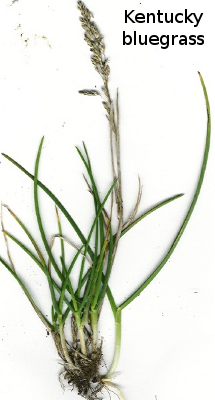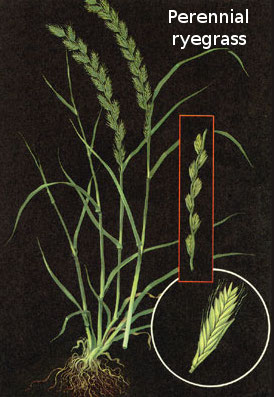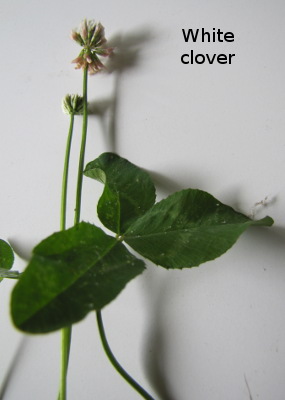
Grasses and legumes for intensive pastures
 When I started my adventures
with chicken pasturing, I tried to micromanage the pasture, adding in
plants that I knew chickens
liked to eat.
In stark contrast, Joel Salatin believes that the most important
characteristic of chicken pastures is a very short sward and that the
individual species aren't as important. The list below introduces
a few of the common pasture grasses and legumes that seem to combine
both characteristics --- easy digestibility and the ability to survive
close grazing or mowing.
When I started my adventures
with chicken pasturing, I tried to micromanage the pasture, adding in
plants that I knew chickens
liked to eat.
In stark contrast, Joel Salatin believes that the most important
characteristic of chicken pastures is a very short sward and that the
individual species aren't as important. The list below introduces
a few of the common pasture grasses and legumes that seem to combine
both characteristics --- easy digestibility and the ability to survive
close grazing or mowing.
Kentucky
bluegrass is
ideal for intensive rotational grazing because it
can handle close grazing and some mismanagement. The species
wants to produce most of its growth in the spring and then slow down in
midsummer, but with good management, Bill Murphy attests that you can
get much more uniform
yields. Kentucky bluegrass shouldn't be confused with Canada
bluegrass, which provides less and lower quality forage for livestock,
but which does better in poor soil.
Perennial
ryegrass is an
ideal pasture grass if you live in zone 5 or
warmer and can provide high nitrogen and moist growing
conditions. The leaves contain a lot of  nonstructural
carbohydrates, which means they're very digestible and might be a good
choice for chickens.
nonstructural
carbohydrates, which means they're very digestible and might be a good
choice for chickens.
Orchardgrass can handle moderate soil
fertility and low moisture, but
it tends to get tall and inedible quickly if not grazed
carefully. If you have orchardgrass, you'll need to graze early
and often since chickens can't digest tough leaves.
Timothy has a lot of advantages,
being very palatable, persistent, easy
to establish, and tolerant of poor drainage. However, the grass
can't
handle drought and has a low yield. Timothy is a taller grass
than the others mentioned here, but can tolerate close grazing.
White
clover is the
primary legume in management intensive pastures
since it survives close grazing and grows quickly. When mixing
grasses with white clover, you need to graze or mow the grasses closely
in the spring so that they don't shade out the legumes.
 Red clover is
more deep-rooted and can withstand drought, but is also more upright,
so
can't deal with close grazing. Alfalfa is even more deep-rooted,
but can't handle frequent grazing, requiring a 25 to 30 day recovery
period even in the spring.
Red clover is
more deep-rooted and can withstand drought, but is also more upright,
so
can't deal with close grazing. Alfalfa is even more deep-rooted,
but can't handle frequent grazing, requiring a 25 to 30 day recovery
period even in the spring.
Gene Logsdon's All Flesh
is Grass is
sitting on my shelf waiting to provide my continued pasture
education. A quick flip through the book suggests that it will
give additional information on good pasture species, so I'll write more
on that topic later this fall. In the meantime, I'm
inclined to believe that Joel Salatin and Bill Murphy know what they're
talking about --- even young, tender fescue leaves are probably
more tasty to chickens than old bluegrass leaves from plants gone to
seed.
| This post is part of our Greener Pastures on Your Side of the Fence
lunchtime series.
Read all of the entries: |
Want more in-depth information? Browse through our books.
Or explore more posts by date or by subject.
About us: Anna Hess and Mark Hamilton spent over a decade living self-sufficiently in the mountains of Virginia before moving north to start over from scratch in the foothills of Ohio. They've experimented with permaculture, no-till gardening, trailersteading, home-based microbusinesses and much more, writing about their adventures in both blogs and books.
Want to be notified when new comments are posted on this page? Click on the RSS button after you add a comment to subscribe to the comment feed, or simply check the box beside "email replies to me" while writing your comment.
- Remove comment
- Remove comment
